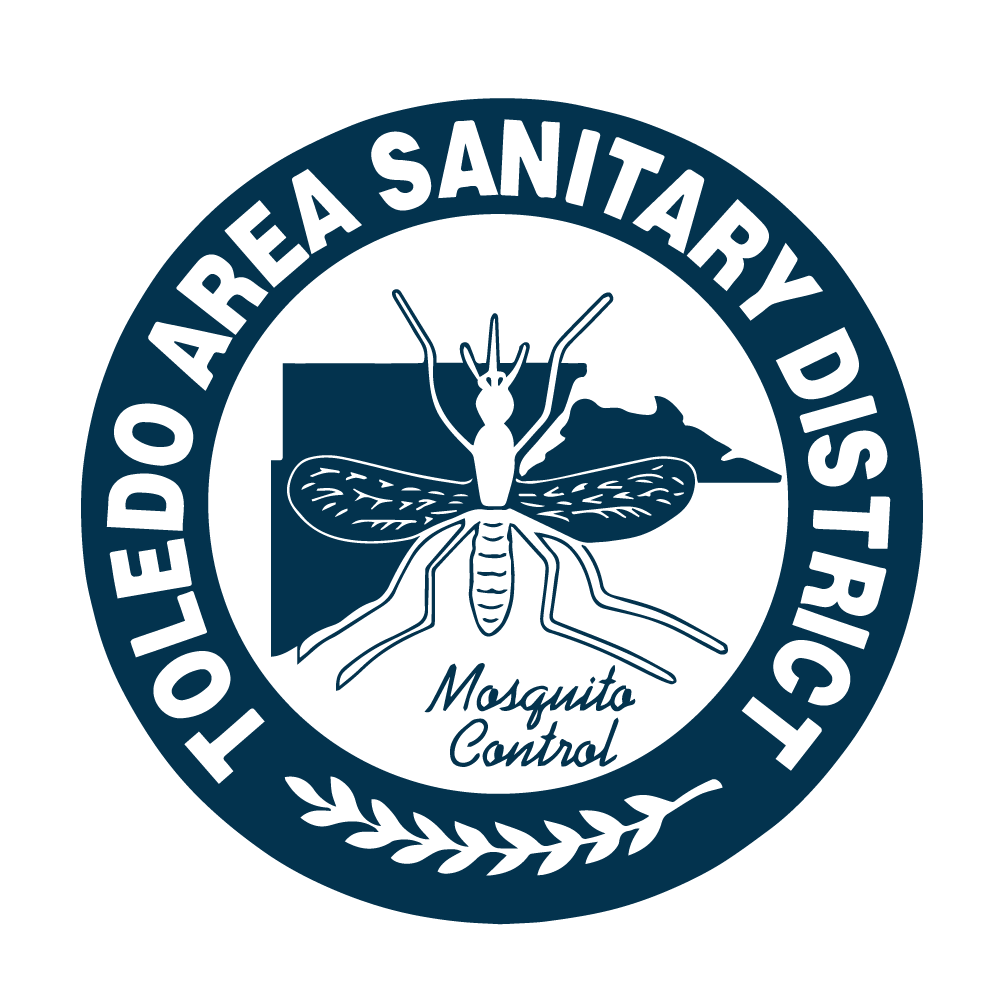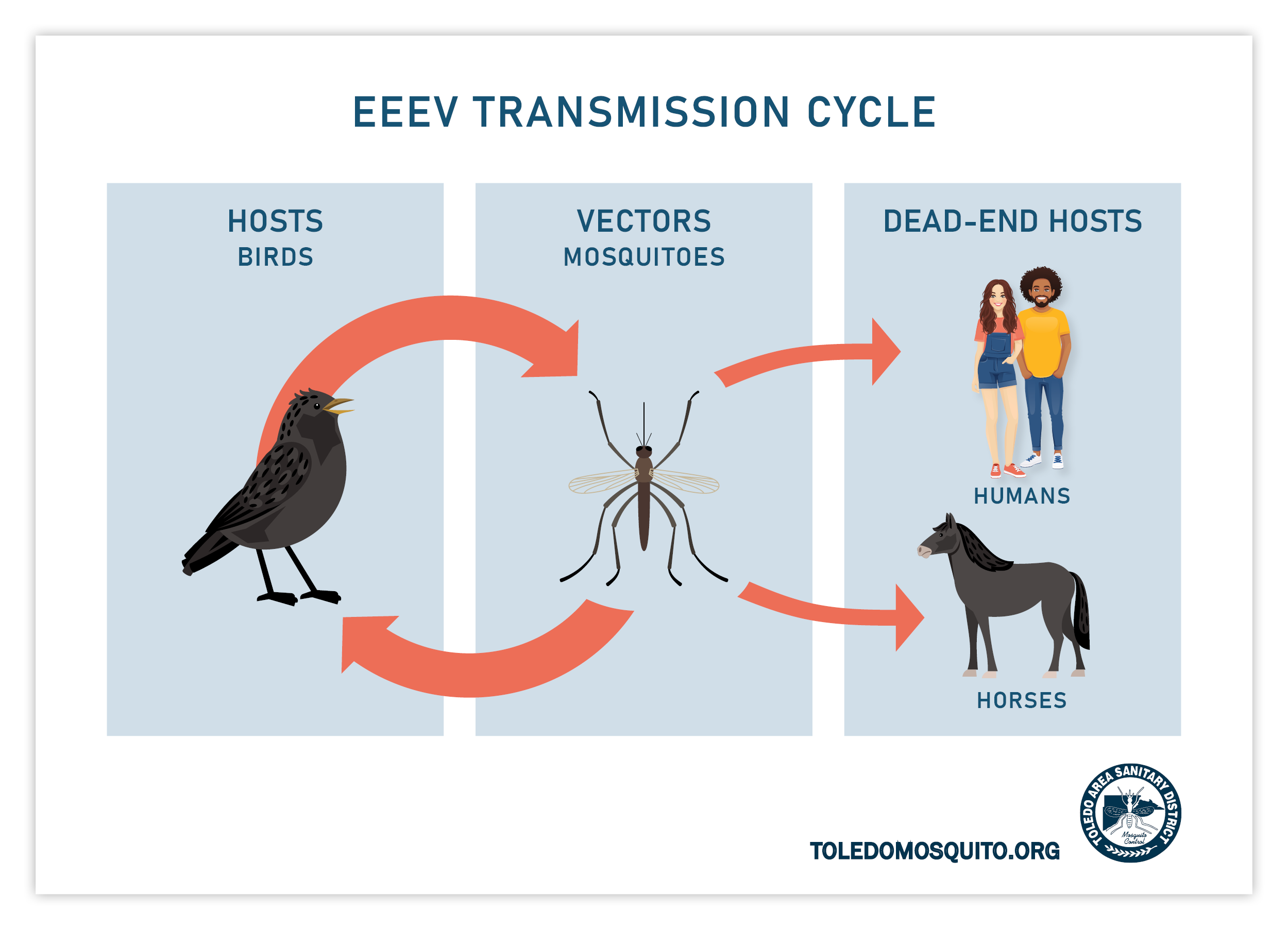
MOSQUITO-BORNE
DISEASES
-
When it comes to mosquito-borne disease transmission, West Nile virus (WNV) continues to pose the biggest threat to Lucas County residents. Historically found in Africa, Eastern Europe, West and Central Asia, and the Middle East, WNV first appeared in North America with an outbreak in the New York City metropolitan area in late summer 1999. WNV spread to the west and south and eventually reached Ohio in 2001, causing the deaths of several hundred birds. The first human illness in Ohio due to WNV occurred in 2002. WNV can now be found throughout the continental United States and the Western Hemisphere.
People get WNV from the bite of a mosquito that is infected with the disease from previously feeding on an infected bird. West Nile virus is not transmitted from person to person. People do not build up enough virus in their bloodstream to infect other mosquitoes and are “dead-end” hosts that do not continue the disease cycle. In Ohio, the northern house mosquito, Culex pipiens, is believed to be the primary vector to humans. Only a small proportion of other mosquito species can be infected with WNV. Mosquitoes become infected after biting infected wild birds that serve as the primary host of the virus. Members of the Corvidae bird family, especially crows and bluejays, are very susceptible to WNV and frequently die from the disease. Many other kinds of birds may also become sick and die from the disease. Horses can also become infected but, WNV is extremely rare in other animals, such as dogs.
Most people infected with WNV display no symptoms of illness, but some may become ill 3 to 15 days after the bite of an infected mosquito. Mild symptoms of the disease may include fever, headache, and muscle aches. About 1 out of 150 people develop more severe symptoms, such as high fever, severe headaches, stiff neck, confusion, or muscle weakness, which can result in hospitalization and even death. Those inflicted with severe cases of WNV often experience lifelong complications and side effects from the illness.
-
Zika virus was first discovered in 1947 and is named after the Zika Forest in Uganda. In 1952, the first human cases of Zika were detected and since then, outbreaks of Zika have been reported in tropical Africa, Southeast Asia, and the Pacific Islands. Before 2007, only 14 cases of Zika had been documented, but in 2014 Zika virus spread and was detected for the first time in the Western Hemisphere. By 2016, it had spread to 45 countries and as of March 2017, there have been over 43,000 human cases of Zika virus infections identified.
In Lucas County, TASD has found one species of mosquito, Aedes albopictus (the Asian Tiger mosquito), known to potentially spread this disease. Unlike WNV, Zika virus infections result in high enough virus levels in the bloodstream for people to infect mosquitoes when they are biting us: furthering the disease transmission cycle.
Many people infected with the Zika virus won’t have symptoms or will only have mild symptoms. The most common symptoms of Zika are fever, rash, headache, joint pain, red eyes, and muscle pain. These symptoms can last for several days to a week. People usually don’t get sick enough to go to the hospital, and they very rarely die of Zika. Once a person has been infected with Zika, they are likely to be protected from future infections. Zika infection during pregnancy can cause a birth defect of the brain called microcephaly and other severe brain defects. It is also linked to other problems, such as miscarriage, stillbirth, and other birth defects. There have also been increased reports of Guillain-Barré syndrome, an uncommon sickness of the nervous system, in areas affected by Zika.
-
Aedes triseriatus (the Tree-hole mosquito), commonly found throughout Lucas County, is the mosquito species primarily responsible for the transmission of LaCrosse encephalitis virus (LACV) to people. Many people infected with LACV have no apparent symptoms. Among people who become ill, initial symptoms include fever, headache, nausea, vomiting, and tiredness. Some of those who become ill develop severe neuroinvasive disease (a disease that affects the nervous system). Severe LACV disease often involves encephalitis (an inflammation of the brain) and can include seizures, coma, and paralysis. Severe disease occurs most often in children under the age of 16. In rare cases, long-term disability or death can result from La Crosse encephalitis. Ohio typically leads the nation in the number of LACV cases identified each year.
-
Far less common in Ohio is the Eastern equine encephalitis virus which is a rare cause of brain infections. To date, there have not been any human cases of EEE acquired locally in Ohio. Infected people may be asymptomatic (will not develop any symptoms) or they may display extreme neurological symptoms. According to the CDC, approximately one-third of all people with EEE die from the disease. Death usually occurs 2 to 10 days after the onset of symptoms but can occur much later. Of those who recover, many are left with disabling and progressive mental and physical ailments, which can range from minimal brain dysfunction to severe intellectual impairment, personality disorders, seizures, paralysis, and cranial nerve dysfunction. Many patients with these severe lasting impacts die within a few years.
The EEE virus is primarily maintained in a bird mosquito cycle between Culiseta melanura mosquitoes and birds. A bridge vector that will feed on both birds and other mammals is required to transmit the virus from birds to animals and people. The primary mosquito species of concern in Lucas County that could be responsible for being the bridge vector is Coquillettidia perturbans, the cattail mosquito.
-
Heartworm (Dirofilaria immitis) is a mosquito-borne disease discovered in 1856 and is common throughout Ohio as well as most of the United States. It is primarily associated with dogs and other canids such as wolves, foxes, coyotes, and to a lesser extent cats and ferrets. Heartworm is classified as a nematode (roundworm), and is transmitted by various Aedes mosquitoes. Symptoms of heartworm infection range in severity. Some common symptoms in dogs are tiring easily, shortness of breath, and coughing. If your dog exhibits any of these symptoms the best course of action is to see a veterinarian for proper diagnosis. Veterinarians can also prescribe preventative medication. Human infections are rare and are not considered high risks at this time. More information on heartworm can be found through the American Heartworm Society.
TRAVEL-ASSOCIATED DISEASES
With increased domestic and international travel, there is an increased risk of travel-associated mosquito-borne diseases being introduced to Lucas County. Diseases such as Zika Virus, Chikungunya Virus, Dengue Fever, Japanese Encephalitis, Yellow Fever, and Malaria are monitored by the local health department and the Ohio Department of Health. TASD receives updates on the number of travel-associated mosquito-borne diseases on a regular basis throughout the mosquito season and may focus control efforts in response to these travel cases in an effort to reduce the risk of the pathogens being introduced into our local mosquito populations. Lucas County has mosquito species that can transmit these diseases if they were to become infected, and the possibility of local transmission of these diseases remains a concern. More information on these diseases can be found through the CDC Division of Vector-Borne Diseases. Statistics on the number of travel-associated cases of these diseases in Ohio can be obtained from the Ohio Department of Health.


